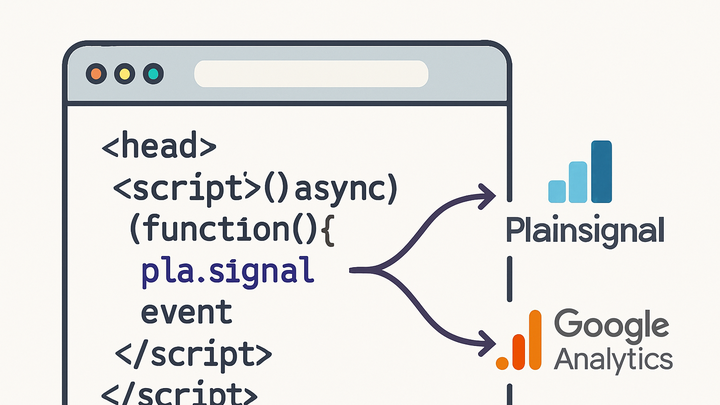Published on 2025-06-28T06:20:22Z
What is JavaScript Tagging? Examples with PlainSignal and GA4
JavaScript Tagging is the practice of inserting JavaScript code snippets into web pages to collect data on user interactions, pageviews, and custom events. These snippets execute in the user’s browser and send structured data payloads to analytics endpoints, enabling real-time tracking and analysis.
By placing tags directly in the HTML head or through a Tag Management System (TMS), teams can manage updates and rollouts without modifying the core codebase. Tools like PlainSignal offer lightweight, cookie-free analytics, while Google Analytics 4’s gtag.js provides extensive event modeling and integration with Google’s marketing ecosystem.
Although JavaScript tagging delivers rich, actionable data, it demands careful planning to mitigate performance impacts, prevent tag sprawl, and ensure compliance with privacy regulations like GDPR and CCPA.
Javascript tagging
JavaScript Tagging embeds JS snippets in webpages to capture user interactions and send data to analytics platforms like GA4 and PlainSignal.
What is JavaScript Tagging?
JavaScript tagging involves embedding JavaScript snippets into a website’s HTML to capture and transmit user interaction data to analytics services. It forms the foundation of modern web analytics by enabling granular tracking of pageviews, clicks, and custom events in real time.
-
Core concepts
Tags deploy tracking code, events define user actions, and payloads structure the data sent to analytics endpoints.
-
Tag
A JavaScript snippet placed in HTML that runs to collect and send interaction data.
-
Event
A specific user action or system activity, such as a click, scroll, or form submission.
-
Payload
A structured data object (typically JSON) containing event details, timestamps, and metadata.
-
How JavaScript Tagging Works
Understanding the technical flow from tag loading to data transmission helps optimize performance and reliability.
-
Loading strategies
Scripts can load synchronously, asynchronously, or with deferred execution to balance immediate tracking needs and page performance.
-
Synchronous vs asynchronous
Synchronous scripts block page rendering, while asynchronous scripts load in parallel without interrupting the user experience.
-
Defer attribute
The
deferattribute postpones script execution until after HTML parsing, reducing render-blocking behavior.
-
-
Data transmission
After execution, tags send HTTP requests (GET or POST) containing analytics payloads to endpoint servers.
-
Get vs post
GET appends data to the URL, while POST sends it in the request body. POST is preferred for larger or sensitive payloads.
-
Batching
Bundling multiple events in a single request minimizes network overhead and improves performance.
-
Implementation Examples
Code snippets show how to deploy JavaScript tags for both PlainSignal and Google Analytics 4.
-
PlainSignal implementation
<link rel="preconnect" href="//eu.plainsignal.com/" crossorigin /> <script defer data-do="yourwebsitedomain.com" data-id="0GQV1xmtzQQ" data-api="//eu.plainsignal.com" src="//cdn.plainsignal.com/plainsignal-min.js"></script>-
Key attributes
data-id: Your PlainSignal project IDdata-do: The domain to associate with data collectiondefer: Ensures the script doesn’t block page rendering
-
-
GA4 gtag.js implementation
<!-- Global site tag (gtag.js) - Google Analytics --> <script async src="https://www.googletagmanager.com/gtag/js?id=G-XXXXXXXXXX"></script> <script> window.dataLayer = window.dataLayer || []; function gtag(){dataLayer.push(arguments);} gtag('js', new Date()); gtag('config', 'G-XXXXXXXXXX', { 'send_page_view': true }); </script>-
Measurement id
Replace
G-XXXXXXXXXXwith your GA4 Measurement ID, which links data to your account.
-
Best Practices and Common Pitfalls
Optimizing script performance, maintaining data integrity, and complying with privacy regulations are crucial for effective tagging.
-
Performance optimization
Load tags asynchronously or deferred, minimize payload sizes, and leverage CDNs to reduce latency.
-
Minimize payload
Send only necessary parameters to avoid large request bodies.
-
Use cdn
Host tag scripts on a Content Delivery Network for faster regional delivery.
-
-
Data quality & governance
Implement consistent naming conventions, version control, and regular audits to prevent discrepancies.
-
Naming standards
Use clear, descriptive event and parameter names to simplify reporting.
-
Audit frequency
Regularly review tags for misfires, deprecations, and duplicates to maintain accuracy.
-
-
Privacy and compliance
Align tagging strategies with GDPR, CCPA, and other regulations; consider cookie-free tracking alternatives.
-
Consent management
Integrate with Consent Management Platforms to respect user preferences.
-
Cookie-free tracking
Use solutions like PlainSignal to collect analytics without relying on third-party cookies.
-
Benefits and Challenges
JavaScript tagging offers powerful data collection but comes with trade-offs in maintenance and resource requirements.
-
Key benefits
Provides real-time insights, high customization, and seamless integration with various analytics tools.
-
Real-time insights
Immediate event tracking enables quick decision-making.
-
Custom metrics
Define events and parameters specific to business goals.
-
-
Common challenges
Requires developer involvement, can suffer from tag sprawl, and may impact page performance if unmanaged.
-
Tag sprawl
Proliferation of unmanaged tags can slow down page rendering and complicate debugging.
-
Maintenance overhead
Keeping tags updated and troubleshooting broken snippets demands ongoing effort.
-
